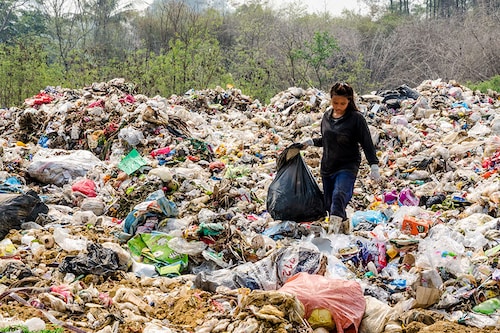Ten things to know about waste
Here are ten facts that demonstrate the importance of significantly reducing—or transforming—the garbage accumulated by humans across the surface of the planet


No less than 2 billion tons of municipal solid waste—ie, all the waste collected and treated within the jurisdiction of municipalities—are produced each year in the world. Enough to fill some 820,000 Olympic-sized swimming pools, according to the World Bank. On the occasion of the International Day of Zero Waste, here are ten facts that demonstrate the importance of significantly reducing—or transforming—the garbage accumulated by humans across the surface of the planet.
Without significant action, global municipal waste production could reach 3.4 billion tons by 2050, an increase of 70% compared to the latest World Bank figures. This includes toxic and hazardous waste that is harmful not only to the environment but also to human health. The international financial institution specifies that the East Asia and the Pacific region is the source of most of the world"s waste (23%), while the Middle East and North Africa region produces the least (6%).
Again according to the World Bank, the average person in the world produces 0.74 kg of waste per day, although there are significant differences depending on the standard of living. The higher the standard of living, the higher the amount of waste. The international institution specifies that the average amount of daily waste per capita varies from 0.11 kg to 4.54 kg depending on the location throughout the world.
Some sectors, such as transportation, have been singled out as being responsible for a major proportion of the world"s greenhouse gas emissions but waste also contributes. According to the United Nations (UN), "decay of the organic proportion of solid waste" is responsible for about 5% of global greenhouse gas emissions. Hence the need for us to reduce the volume of our waste, whether through recycling or composting.
There"s no way to talk about waste without talking about plastic. No fewer than 89 billion plastic water bottles are sold each year worldwide, according to Planetoscope. A mind-boggling figure that takes on an additional dimension when one considers that the lifespan of such a bottle is at least 450 years. Plus there are also the bags and other plastic objects that contribute to the pollution of the planet. A study published in 2017 by the journal Science Advances estimated that 8.3 billion tons of plastic have been generated by humans since the early 1950s.
The reality of the situation couldn"t be more stark: every year, there are new records concerning the amount of plastic polluting the oceans. The latest record was revealed by the American journal PLOS One, which reports no less than 170 trillion pieces of plastic on the surface of the oceans. This would be equivalent to some 2.3 million tons, an unprecedented disaster for the world"s wildlife already threatened by this type of pollution.
Recycling is far from being a reflex for the majority of us. According to the Organization for Economic Cooperation and Development (OECD), not only has the amount of plastic waste doubled worldwide in two decades, but only 9% is recycled. The rest is mostly sent to a landfill, incinerated, or released into the environment, contributing even more to the pollution of soils and oceans.
In addition to municipal garbage and plastic waste, electronic waste from computers, cell phones and other devices has been added to the list for several decades. No less than 53.6 million tons of this waste was generated worldwide in 2019, and the quantity is expected to reach some 74 million tons by 2030, as revealed in the latest Global E-waste Monitor 2020 report. And only about 17% currently gets collected and recycled.
Ranked as one of the most polluting industries, fashion also generates a significant amount of waste throughout the world. According to data published by Ademe (France"s agency for ecological transition), no less than 100 billion items of clothing are sold each year around the world. Production of garments has doubled between 2000 and 2014, while these same clothes are most often worn just ten times—on average—before being thrown away (for the majority) or resold second-hand. Then there"s also the 240,000 tons of plastic microparticles released into the oceans each year, at the global level, linked to the maintenance of synthetic clothing.
Reduce, reuse, and recycle: these are the three "R"s" to remember in order to change things up and try to reduce the impact of waste on the planet. The key is reducing the quantity of single-use products that we consume, to reuse products whenever possible including by finding a new purpose or a new user for it, and finally to recycle suitable materials.
First Published: Mar 31, 2023, 14:32
Subscribe Now